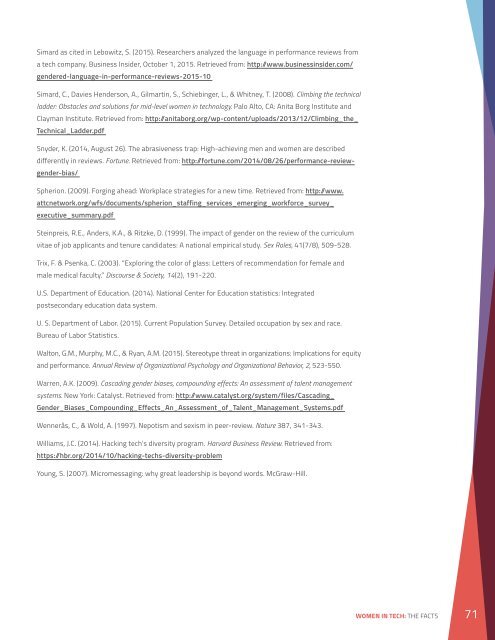WOMEN IN TECH THE FACTS
womenintech_facts_fullreport_05132016
womenintech_facts_fullreport_05132016
Create successful ePaper yourself
Turn your PDF publications into a flip-book with our unique Google optimized e-Paper software.
Simard as cited in Lebowitz, S. (2015). Researchers analyzed the language in performance reviews from<br />
a tech company. Business Insider, October 1, 2015. Retrieved from: http: /www.businessinsider.com/<br />
gendered-language-in-performance-reviews-2015-10<br />
Simard, C., Davies Henderson, A., Gilmartin, S., Schiebinger, L., & Whitney, T. (2008). Climbing the technical<br />
ladder: Obstacles and solutions for mid-level women in technology. Palo Alto, CA: Anita Borg Institute and<br />
Clayman Institute. Retrieved from: http: /anitaborg.org/wp-content/uploads/2013/12/Climbing_the_<br />
Technical_Ladder.pdf<br />
Snyder, K. (2014, August 26). The abrasiveness trap: High-achieving men and women are described<br />
differently in reviews. Fortune. Retrieved from: http: /fortune.com/2014/08/26/performance-reviewgender-bias/<br />
Spherion. (2009). Forging ahead: Workplace strategies for a new time. Retrieved from: http: /www.<br />
attcnetwork.org/wfs/documents/spherion_staffing_services_emerging_workforce_survey_<br />
executive_summary.pdf<br />
Steinpreis, R.E., Anders, K.A., & Ritzke, D. (1999). The impact of gender on the review of the curriculum<br />
vitae of job applicants and tenure candidates: A national empirical study. Sex Roles, 41(7/8), 509-528.<br />
Trix, F. & Psenka, C. (2003). “Exploring the color of glass: Letters of recommendation for female and<br />
male medical faculty.” Discourse & Society, 14(2), 191-220.<br />
U.S. Department of Education. (2014). National Center for Education statistics: Integrated<br />
postsecondary education data system.<br />
U. S. Department of Labor. (2015). Current Population Survey. Detailed occupation by sex and race.<br />
Bureau of Labor Statistics.<br />
Walton, G.M., Murphy, M.C., & Ryan, A.M. (2015). Stereotype threat in organizations: Implications for equity<br />
and performance. Annual Review of Organizational Psychology and Organizational Behavior, 2, 523-550.<br />
Warren, A.K. (2009). Cascading gender biases, compounding effects: An assessment of talent management<br />
systems. New York: Catalyst. Retrieved from: http: /www.catalyst.org/system/files/Cascading_<br />
Gender_Biases_Compounding_Effects_An_Assessment_of_Talent_Management_Systems.pdf<br />
Wennerås, C., & Wold, A. (1997). Nepotism and sexism in peer-review. Nature 387, 341-343.<br />
Williams, J.C. (2014). Hacking tech’s diversity program. Harvard Business Review. Retrieved from:<br />
https: /hbr.org/2014/10/hacking-techs-diversity-problem<br />
Young, S. (2007). Micromessaging: why great leadership is beyond words. McGraw-Hill.<br />
<strong>WOMEN</strong> <strong>IN</strong> <strong>TECH</strong>: <strong>THE</strong> <strong>FACTS</strong> 71


